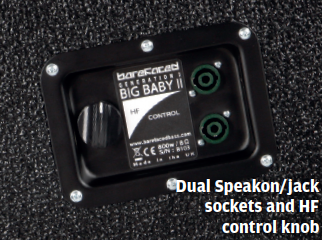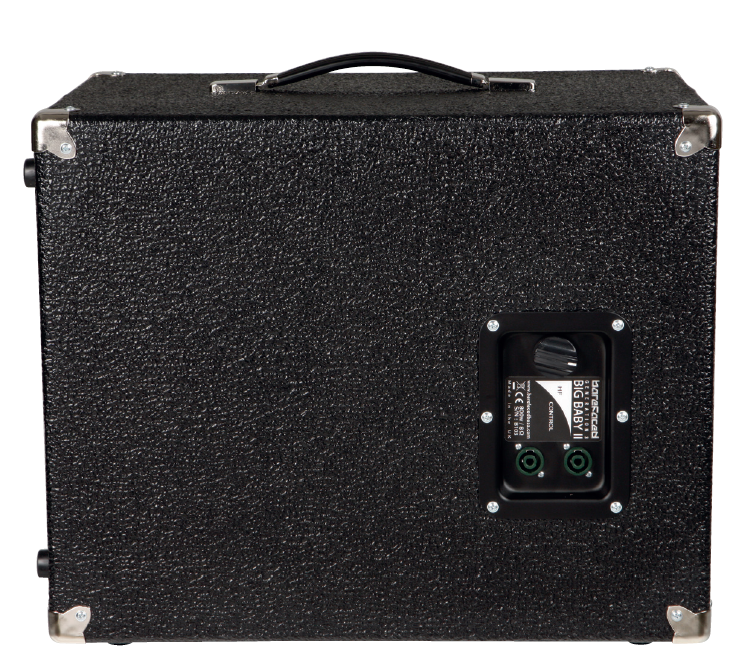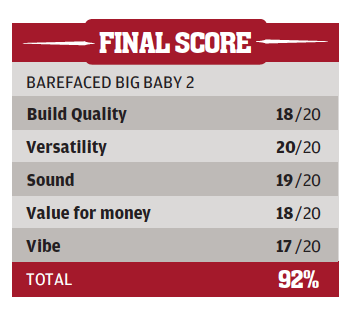Related Tags
Barefaced Big Baby 2 Review
Barefaced bass cabinets were always mighty capable, but the latest generation do an even better job.

Details
Bass guitar/all-purpose speaker cabinet. 8 Ohms, recommended amp power 150-800W. Made in the UK
RRP: £699 (£739 with silver cloth grille)
Contact: Barefaced Bass – 01273 945959 – www.barefacedbass.com
Black boxes: not very interesting, are they? You know… dark, and square. Cuboid and, erm, noir. But let’s bravely forge ahead, for in truth rock’n’roll has been largely built on such items, and this particular black box is rather interesting. Honest.
Barefaced cabinets are built in Brighton, and boss/designer Alex Claber is a whizz when it comes to speakers and speaker enclosures. These days many cabs and combos – even inexpensive ones – boast loudly of ‘custom drivers’, but the ones Barefaced use really are exclusive to them and very, very highly developed (and expensive), while the cabinets are highly braced and built from high-tech mixed-density plywood, making them extremely light.
The smallest Barefaced cabs, the Super Midget and Super Compact, weigh a nutty 23lbs apiece. This Big Baby 2, a two-way 12″ woofer-plus-HF driver unit sits roughly in the middle of the range, can handle a whopping 800W, yet it weighs under 30lbs (and the £40 silver cloth grille option would make it 3lbs lighter again), so with just a single handle you can easily lug it a fair distance.

Let’s break with tradition by listing some of the reasons you should not buy a Barefaced. Firstly, if your idea of a dream bass rig involves purple tolex, custom grille cloths and sexy leather handles, step away; these cabs are all about practicality, with simple metal corners and a textured paint finish that shrugs off chipping (though the Retro Two10 and Six10 do have black vinyl). Secondly, the lightweight construction does mean that the exposed port edge is a little vulnerable; we’d suggest that Barefaced gear is best suited for self-transportation as opposed to being bundled around unflightcased by ape-like stage crew.
Finally, these cabs are direct-order only. A disadvantage? Well, maybe not. It keeps prices down – and also, testing bass gear in a shop rarely gives much idea of how it will cope in real life, so Barefaced’s one-month ‘buy it, try it, and if it doesn’t work out, just send it back’ system seems fair and practical.
Barefaced cabs are now on their third generation, with all-new designs, improved handles, more securely-mounted corners and feet and cleaner, more professional metal grilles. The badge stays the same, but the model name is now routed into the inside of the port slot, which is a cute touch. Around the back, a recessed metal rear panel carries two combined Speakon/jack sockets and a large, friendly cooker-knob style HF control.
 But it’s the stuff on the inside that counts. The latest 12″ driver, the 12XN550, is a frighteningly capable device. G&B has in its stash a Gen 2 Barefaced Midget with the ‘old’ 12″ speaker, and a punchy beast it is – but this one promises higher thermal handling, a wider/cleaner response curve, and far more cone excursion to sock more air around the room. On its own, this new woofer has ‘good response’ to about 4kHz, with the 3″ dome in the middle helping out up to 10kHz. The Faital HF driver, meanwhile, can reach down as far as 2kHz, but the knob on the back shifts the crossover point. Thus, knob full off, the HF driver is only adding ‘air’ above 10kHz; turn it up, and the HF driver begins to take a deeper share of upper frequency responsibility, until finally it’s dealing with everything from 2kHz upwards.
But it’s the stuff on the inside that counts. The latest 12″ driver, the 12XN550, is a frighteningly capable device. G&B has in its stash a Gen 2 Barefaced Midget with the ‘old’ 12″ speaker, and a punchy beast it is – but this one promises higher thermal handling, a wider/cleaner response curve, and far more cone excursion to sock more air around the room. On its own, this new woofer has ‘good response’ to about 4kHz, with the 3″ dome in the middle helping out up to 10kHz. The Faital HF driver, meanwhile, can reach down as far as 2kHz, but the knob on the back shifts the crossover point. Thus, knob full off, the HF driver is only adding ‘air’ above 10kHz; turn it up, and the HF driver begins to take a deeper share of upper frequency responsibility, until finally it’s dealing with everything from 2kHz upwards. In Use
In Use
First let’s try the 12″ driver as best we can by turning the HF control knob off, fully clockwise (slightly counter-intuitive, that). We can’t achieve a true A/B comparison with the old Midget because the cabinets are completely different, but the new driver does seem more balanced and capable throughout its range.
With the amp set flat, the natural amount of bottom isn’t excessive; you can dial in a ton of bass EQ at the amp and the BB2 will pump out those extra lows with consummate ease but, left alone, there’s a sense of a restrained low end, more detailed and articulate mids, and limited yet smooth highs. If this type of slightly ‘traditional’ response is enough for you then the smaller, simpler 1×12″ Super Compact might be an alternative way to go.
To get the full flavour of the BB2’s capabilities we need to tell the HF driver to do more. The way the crossover is configured makes the change in the cab’s performance more subtle, yet somehow more global, than anything you’d get from operating an old-school tweeter control (which usually meant turning down the flippin’ thing until you could just about stand it). Thus the HF driver control gradually turns the BB2 into a truly transparent full-range, flat-response cabinet – though, with bass guitar, it still shows elements of a firm, punchy signature sound.
 With all this clarity and openness on tap it would all too easy for this to morph into an amp review. For example, we found the BB2 conveyed all the rough, doggy roar of an Orange Terror Bass, but dialling in more HF driver added information and articulacy to the upper mids in a welcome way.
With all this clarity and openness on tap it would all too easy for this to morph into an amp review. For example, we found the BB2 conveyed all the rough, doggy roar of an Orange Terror Bass, but dialling in more HF driver added information and articulacy to the upper mids in a welcome way.
Fed the more wide-ranging EQ options of an Aguilar TH500, the BB2 exposes the way its Drive and Gain knobs work together to create grit and EQ shaping and the precise nature of the amp’s baked-in upper mids in a way that more forgiving cabs might well disguise. Chances are that what you put into the BB2, whether old-school valves or high-tech switch-mode, you’ll get out.
We haven’t mentioned volume. Well, the BB2 adores gobs of power and it can get ridiculously, stupidly loud. With enough amp yet with zero PA support in a crowded, fair-sized room, one of these can easily keep pace with a deranged, spiral-eyed drummer and a guitarist seemingly set on drowning out a jet plane on takeoff. Having gigged it, we’d guess that a BB2, given enough watts, should be able to handle almost any local-type indoor gig unsupported, and with a pair of them you’d be ready to cover a very large stage indeed.
There’s a third aspect to the Big Baby 2, for its full-range, flat-response capabilities hint at an intriguing hook-up with modelled guitar sounds. Rigging up a Line 6 unit with a power amp giving 500W into the BB2’s 8 Ohms, the sound is huge and extremely convincing, with fine spread around the room, highs that sound natural and unforced, and the potential of some shattering SPLs. We also performed some experimentation with an electro-acoustic rig and began to obtain results which were richly detailed and equally promising in scale.
Verdict
The Big Baby 2 is a very potent design. It’s clear and revealing rather than retro and flattering, yet it can move from fat and fairly characterful bass goodness to super-accurate monitor-like sound reproduction at the twist of a knob. That means it’s not just an epic bass cab but also a modelling guitar solution, a PA speaker, the centre of an electro-acoustic rig and no doubt a fine double bass cab.
For volume you definitely won’t be complaining, and the portability is a bonus. There are many cheaper speaker cabs, and a handful of more expensive ones, but we’d say that this one is close to being out on its own for cutting-edge technical specs and for real-world capabilities.
